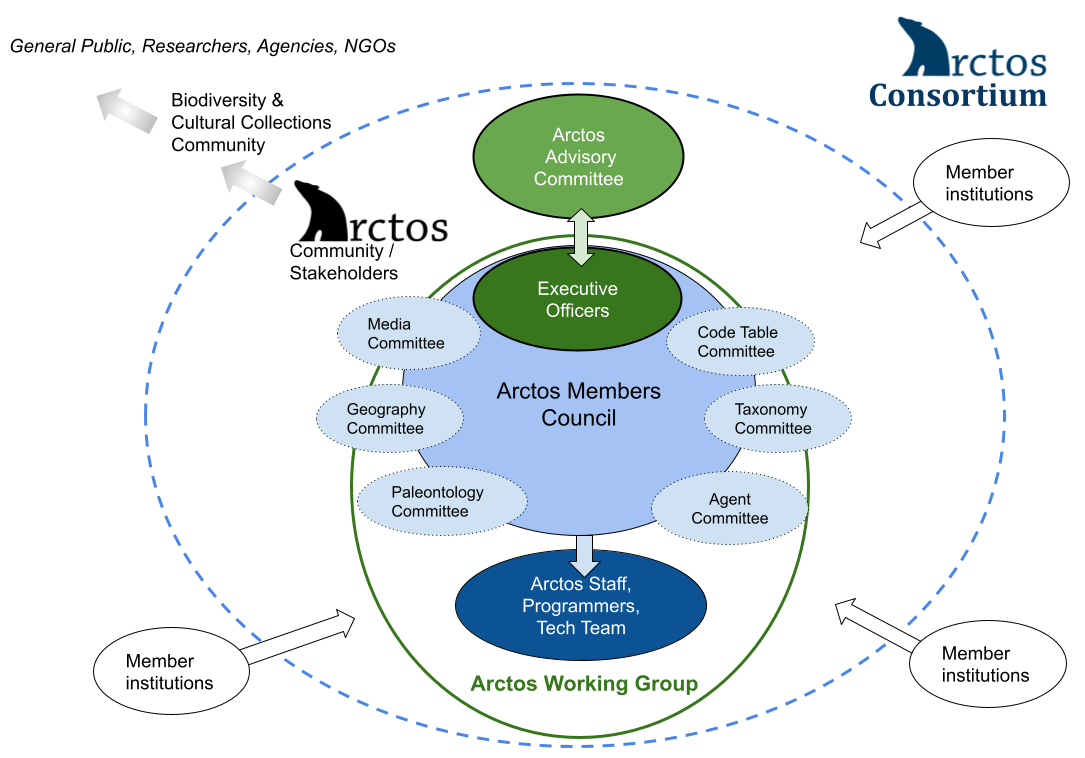Arctos is governed by the Arctos community. An Arctos Advisory Committee oversees the strategic planning for the Arctos Consortium. The nitty gritty operations of Arctos are managed by an elected executive committee, which consists of museum curators and collection managers who oversee communications, documentation, development priorities, and outreach in conjunction with a users group, the Arctos Working Group. The director of the executive committee serves as the liaison between the Advisory Committee, Arctos staff, and the Arctos Working Group.
View Contacts for a list of current Advisory Committee, Arctos officers and other technical members.
Governing Principles:
- Normalization of information guides both the structure of Arctos and its relationships to other resources on the Internet. Normalization is the process of eliminating redundant data. Providing that it is logically organized, information needs to be represented only once for retrieval in different contexts or formats. We cannot anticipate future ways in which our data may be used, therefore we should normalize it for maximum flexibility. A strength of Arctos is that it was formally modeled by Stan Blum and Barbara Stein as the MVZ Model, and we have resisted temptations to simplify it for specific applications.
- Standardization matters. Where accepted vocabularies exist in larger scientific contexts, Arctos endeavors to use them. Where standards do not exist, Arctos endeavors to establish emerging standards. Much vocabulary in Arctos is controlled by drop-downs (code tables) or pick lists (authority tables), and these data values are shared by all relevant collections. Data on taxonomy, places (including higher geography, localities, spatial coordinates), and agents (people, organizations) are shared across all collections. Likewise, part names also are shared across collections of a specific type (e.g., birds, mammals, etc.).
- The code base is shared. Arctos code is open source, and developers of Arctos work from a shared code repository on Github. What works for one collection must work for similar collections, assuming that they elect to use the particular feature.
- Community input is important. Arctos users form a community whose input directs development. Significant changes to Arctos require discussion among users. Such discussion, and posting of new issues, are communicated via the Arctos Google Group and the Arctos Working Group. Issues are posted, prioritized, and tracked on Github.
- New collections and/or data types are welcome. The sustainability of Arctos depends on growing its community of collections. New collections must provide financial and personnel support for data migration and annual maintenance, and collections that submit grant proposals involving Arctos must include funding in their budget. If you are interested in having your data shared in Arctos, read this.
Administratively, the Arctos Consortium, is a fiscally sponsored project of Community Initiatives, a US 501(c)(3) nonprofit organization. In practical terms, this means Community Initiatives takes care of our HR, legal filings, and other matters of a nonprofit organization so we can focus on the Arctos community, collection management software, and the ever-changing informatics technologies to fulfill our mission.
Note: Featured image above is of a tusk cultural artifact in the University of Alaska Museum. This was gifted to President William H. Taft from the people of Fairbanks and the Tanana Valley, Alaska. View its Arctos record for detailed information.
